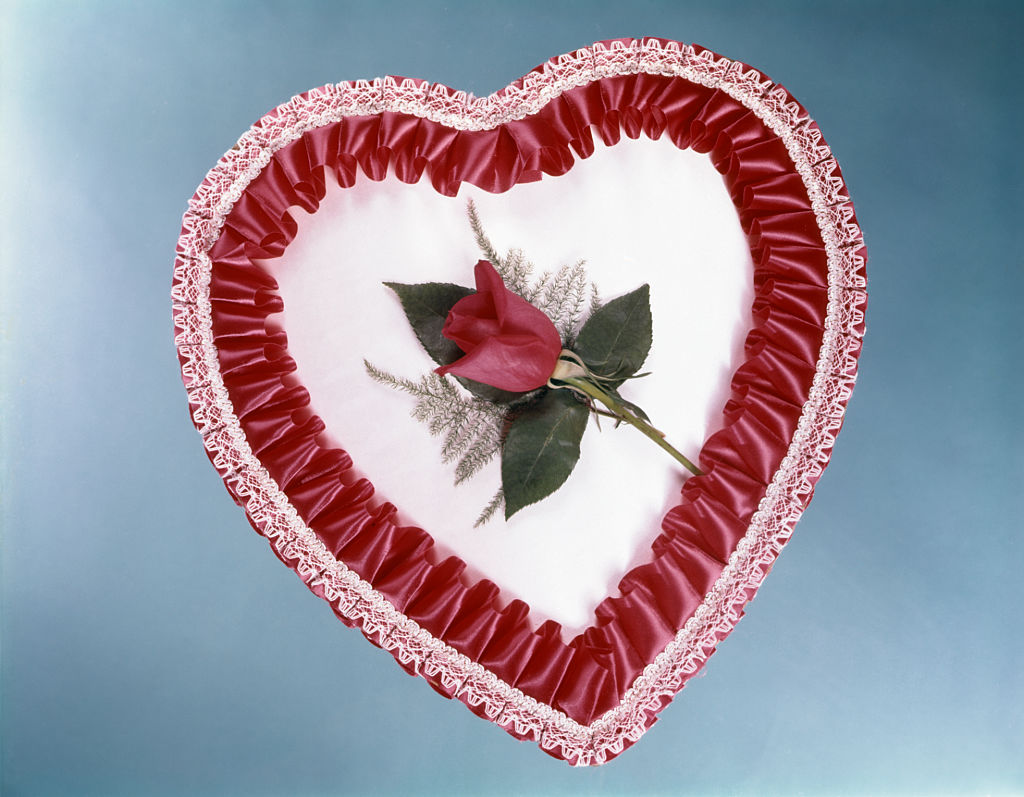
For those looking to cook a special Valentine’s Day meal, the internet is flooded with recipes. You might expect chocolate-dipped strawberries, seafood in creamy sauces, or beef Wellington, the sorts of rich, decadent foods long associated with the sensuous holiday. These days, however, food bloggers often offer low-calorie alternatives—and argue that they’ll produce better romance.
One food site, for example, serves up a “French Kiss” vegan Valentine’s Day menu of vegetable soup with pesto, a vegetarian pâté sandwich, eggplant Florentine, and potatoes with lentils. This is hardly the familiar stuff of romance, yet the post features a photo of a kissing couple standing in front of the Eiffel Tower.
[time-brightcove not-tgx=”true”]
Indeed, the perceived relationship between food and romance has flipped over the last quarter century. Until the sexual revolution of the 1960s, physicians and moralists alike warned against eating flavorful, rich foods that would heighten lustful appetites. But just as social norms shifted in the late 20th century from stigmatizing non-marital sex to valorizing fun in the bedroom, new more restrictive attitudes towards body fat emerged that sapped rich foods of their aphrodisiac reputations—and recast them as harmful to a good sex life. In the 21st century, many wellness influencers argue that low-calorie diets are critical for heightening the lustful appetites, producing everything from a strong sex drive, to a firm erection, to a desirable body.
The belief that flavorful foods drove lust dates back to ancient times. The fourth-century Christian monk Evagrius Ponticus advised that “gluttony is the mother of lust,” and the medieval author Thomas à Kempis warned that “when the belly is full to bursting with food and drink, debauchery knocks at the door.” In 18th-century Britain, John Wesley, the founder of Methodism, advised believers to avoid “high-season’d dishes” including anything pickled or smoked to keep their lusts in check.
The invention of the modern restaurant in late-18th-century Paris exacerbated Anglo anxieties linking good food with illicit sex, which at the time meant sex outside of marriage. Many of the early restaurants had glamorous “dames de comptoirs,” sexy women cashiers who sat on high thrones overlooking the public room and “cabinets particuliers,” private rooms where wealthy men could meet women for sexual rendezvouses. The dictionary writer Pierre Larousse called these rooms “the principal attraction of renowned restaurants.” A French journalist said the couches inside were their “plat de résistance,” or main course.
Read More: An Alternative Guide for Valentine’s Day
When British and American tourists visited Paris in the early 1800s, they were titillated by the restaurants’ erotic attractions, describing the scandalous new eateries in travel books for readers back home to consume. The rise of the modern restaurant around the world fixed the association between French food and sexual indulgence in the Anglo-American imagination.
French food retained its sexual frisson as restaurants spread to the U.S. and Britain after the 1830s. Many early restaurants in New York, London, and San Francisco had private rooms. The Poodle Dog, a French restaurant in San Francisco dating back to the Gold Rush, gleefully advertised the elevators that carried customers up to its notorious private rooms.
In fact, in the 19th century, restaurants were so associated with illicit sexual encounters that some women refused to eat in them. Victorian culture encouraged women to deny their alimentary appetites. Even at home, women were discouraged from indulging. “The ladies were supposed only to nibble,” Edith Wharton wrote in a short story featuring a dinner party. Many mothers instructed daughters to eat lightly at public meals, avoiding butter sauces and other indulgent foods that might hint at their sexual appetites.
After the Victorian era, the taboo weakened on women eating in public. Further, while the linkage between rich and indulgent foods and lust remained engrained, it lost some of its power.
Nonetheless, the stigma did not entirely vanish. In her 1935 dieting memoir, No Food with My Meals, the novelist Fanny Hurst wrote that “undereating may generally be counted as a cardinal virtue,” particularly “since nature has seen fit to pester the human race with various appetites which are so far and away beyond requirements.” In other words: starving the body of food was a good way to keep those other appetites under control as well.
Sensuous food and French food in particular, retained its association with lustful appetites throughout the 1960s. The food writer Mimi Sheraton wrote in 1963 that the girl next door “may blush when you suggest going to a French restaurant.” Cookbook authors suggested preparing French food at home to seduce a lover. Cosmopolitan Magazine editor Helen Gurley Brown’s Single Girl’s Cookbook (1969) promised that her recipe for boeuf en daube had “undone more men than the Hong Kong virus, only it’s a good kind of undoing. It definitely got one girl I know married.” While the thin Brown famously subsisted off cigarettes and liver-yeast shakes, she advised women on the manhunt: “you almost have to cook with cream, butter, whole milk, brandy and even sugar.” Men, she suggested, could be seduced with indulgent meals.
Brown’s recommendations reflected a truism: Americans believed that low-calorie food, especially vegetarian food, was a mood killer.
The sexual revolution, however, upended the long-held beliefs about the relationship between food and romance. As the stigma against sex outside of marriage weakened, and the invention of the birth control pill decoupled sex from procreation, concerns about the lust-inducing properties of rich food seemed to vanish.
Read More: Can Food Really Change Your Hormones?
This shift, however, did not free Americans from the moral anxieties attached to food and sex. Instead, the relaxation of old rules led to the rise of new ones.
After the sexual revolution, “bad sex” was redefined from immoral sex to inadequate sex. Instead of worrying that rich foods would lead to lustful appetites, Americans began worrying that rich foods would kill their libidos. The solution offered up by some: the sort of abstemious, low-fat, often vegetarian, diets that had been prescribed as lust-control regimens only decades earlier.
According to the new dietary belief system, the best sex required skinny bodies, which depended on denying the appetites. Morton Walker, a doctor and author of numerous books on sex and nutrition published in the 1980s and 1990s, explained to his readers: “Today, being sexy means, for both men and women, being well-nourished, fit, and trim.” He prescribed a diet of whole-grain bread, lentil soup, fresh raw salad, and small amounts of lean meat. “The problem of a lackluster sex life—or even of just a good as opposed to fantastic sex life—frequently comes from nutritional shortcomings or dietary indiscretions,” Walker wrote.
Dietary advice linking restrictive diets to sexual passion really took off in the 2000s, with the rise of social media. Juan-Carlos Cruz, a pastry chef who became famous after appearing on a weight-loss show, co-authored a 2010 cookbook, The Love Diet (2010), with the slogan: “eat it up, take it off, get it on.” Cruz testified that getting fit had improved his sexual prowess. More recent cookbooks, like Lisa Davis’s Clean Eating, Dirty Sex (2019), warn that high fat foods cause erectile dysfunction and lowered libido and “weight gain. Not sexy.”

On the surface, dietary advice to eat more vegetables hardly seems pernicious. But the new advice comes with costs. It can produce unhealthy eating or even eating disorders in the name of becoming attractive to potential lovers or ensuring better sexual encounters.
The reality is that when the sexual revolution shattered the taboo that eating rich foods would fuel an insatiable libido, society would have been better off not replacing that anxiety with a new system of body discipline. People would benefit if, rather than worrying about the impact Valentine’s Day dinner might have on their romantic prospects, they enjoyed a meal with a lover without judging themselves for the food or what might follow.
Rachel Hope Cleves is professor of history at the University of Victoria in British Columbia and the author of three-prize winning histories and one novel, co-authored under the pseudonym R.A. Sinn. Her newest book, Lustful Appetites: An Intimate History of Good Food and Wicked Sex is out now from Polity Press.
Made by History takes readers beyond the headlines with articles written and edited by professional historians. Learn more about Made by History at TIME here. Opinions expressed do not necessarily reflect the views of TIME editors.



